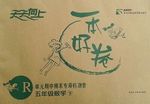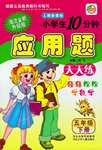
Watercolor(水彩畫) is the oldest paints known. It dates back to the early cave men. They discovered that they could mix the natural colors found in the earth with water. In this way they could add lifelike qualities to drawings of animals and other figures on the wall of caves.
Fresco(壁畫), one of the greatest art forms, is done with watercolor, it is created by mixing paints and water and applying these to wet plaster(灰泥). Of the thousands of people who stand under Michelangelos’ works in the Sistine Chapel, very few know they are looking at perhaps the greatest watercolor painting in the world.
and water and applying these to wet plaster(灰泥). Of the thousands of people who stand under Michelangelos’ works in the Sistine Chapel, very few know they are looking at perhaps the greatest watercolor painting in the world.
The invention of oil painting by the Glemish masters in the fifteenth century made fresco painting go downhill, and for the next several centuries watercolor was used mainly for doing sketches(素描) or as tool for study. It was not until the eighteenth and nineteenth centuries that English painters put back watercolor as a serious art form. The English have widely-known love for the outdoors and also for small, private pictures. The softness o f watercolor had a strong attraction for them.
f watercolor had a strong attraction for them.
The popularity of watercolor continued to grow until the twentieth century. The United States took the place of England and became the cen ter of watercolor. It produced such well-known watercolor artists as Thomas Eakins and Andrew Wyeth.
ter of watercolor. It produced such well-known watercolor artists as Thomas Eakins and Andrew Wyeth.
【小題1】 The first watercolor users were___________
| A.the early cave men |
| B.Italian fresco artists |
| C.Flemish masters |
| D.the English artists in the 18th century |
| A.watercolor was more costly, but better |
| B.oil painting lasted less long, but clearer and brighter |
| C.watercolor was not suitable for serious works |
D.oil painting was difficult to use was difficult to use |
| A.it was easy to use outdoors |
| B.it was a strong tool |
| C.it was extremely bright in color |
| D.it was well suited to popular tastes |
| A.the gradual weakness of fresco painting. |
| B.Oils having more power of influence over watercolor. |
| C.The rediscovery of watercolor in England. |
| D.The start and development of watercolor. |
 天天向上一本好卷系列答案
天天向上一本好卷系列答案 小學(xué)生10分鐘應(yīng)用題系列答案
小學(xué)生10分鐘應(yīng)用題系列答案科目:高中英語 來源: 題型:閱讀理解
Have you ever wanted to travel back through time and see what life was like at the dawn(起始) of man? Well, museums can make history come alive. And one museum in particular can take you on an exciting journey from the beginning of human culture to the present day.
It is the British Museum. Being one of the largest museums in the world, it is home to over 7 million objects from all the world’s continents. While most of us may not have the opportunity to visit London, we can catch a glimpse of the treasures it holds in Beijing. More than 100 cultural relics will be on display in the Palace Museum. Named “Britain and the World”, a range of pencil sketches (素描), watercolor paintings, sculptures and many other objects have traveled to China.
There will be several Chinese objects on show. But “they were obtained by the British Museum before 1830 mainly by trade,” said Ma Jige, deputy director of the Exhibition Department of the Palace Museum.
In fact, there are more than 23,000 Chinese relics in the British Museum, including national treasures like gems (寶石), artwork and ancient bronze ware objects.
The museum is famed for its exquisite Chinese paintings. Picture of Lady Officials (《女史箴圖》) by Gu Kaizhi, a top painter of the Eastern Jin Dynasty (AD 317-420), is there. The British Museum also holds 13,700 Buddhist records from the Dunhuang Grottoes in Gansu Province.
From the passage we can learn that ________.
A. the British Museum will be moved to Beijing
B. pictures of some objects belonging to the British Museum will be taken to Beijing
C. pictures of the British Museum will be on show in Beijing
D. some objects of the British Museum will be on show in Beijing
The Chinese objects on show were mainly _______ by the British Museum.
A. stolen B. bought C. borrowed D. robbed
How many Chinese relics are there in the British Museum?
A. About 100. B. About 1,830. C. About 13,700. D. Over 23,000.
查看答案和解析>>
科目:高中英語 來源:江西省2009-2010學(xué)年高二下學(xué)期第二次月考英語試題 題型:閱讀理解
Since my retirement(退休) from teaching music in 2001 , I have spent a good deal of time painting as an artist . I actually began drawing again in the summer of 1995 when my father died , so perhaps I was trying to recover from the loss of my father , or maybe it was just that it brought back memories of him . In any case , I drew pen and ink animals and landscapes(風(fēng)景畫) much influenced by Krenkel and St. John for five years .
For some strange reason , I had been waiting until my retirement to start doing watercolors again , but as soon as I walked out of the school door for the last time I picked up my brushes and rediscovered Andrew Wyeth , who quickly became my favorite artist . I had looked through all the art books I had on my shelves and found his watercolors to be the closest to how I thought good watercolors should look . So I painted landscapes around Minnesota for three years and tried out many other types of painting . However , watercolors remained my first choice , and I think I did my best work there , showing my paintings at a number of art exhibitions .
Art is now together with my piano playing and reading . There is a time of everything in my world , and it is wonderful to have some time doing what I want to do . As Confucius once said , “ At seventy I can follow my heart’s desire .”
1. What is the text mainly about ?
A. Learning to paint in later life . B. How to paint wathercolors .
C. An artist-turned teacher . D. Life after retirement .
2. The author started drawing again in 1995 because__________.
A. he hoped to draw a picture of his father
B. he couldn’t stop missing his father
C. he had more time after retirement
D. he liked animals and landscapes
3. We can infer from the text that the author_______.
A. had been taught by Krenkel and St.John
B. painted landscapes in Minnesota for 5 years
C. believed Wyeth to be the best in watercolor
D. started his retirement life at the age of seventy
4. How does the author probably feel about his life as an artist?
A. Very enjoyable B. A bit regretful C. Rather busy D. Fairly dull
查看答案和解析>>
科目:高中英語 來源:2010-2011學(xué)年福建省廈門市高三上學(xué)期10月月考英語卷 題型:閱讀理解
Watercolor is the oldest paints known. It dates back to the early cave men who discovered they could add lifelike qualities to drawings of animals and other figures on the walls of caves by mixing the natural colors found in the earth with water.
Fresco (壁畫), one of the greatest of all art forms, is done with watercolor. It is created by mixing paints and water and applying these to wet plaster (灰泥). Of the thousands of people who stand under Michelangelo’s heroic ceiling in the Sistine Chapel, very few know that they are looking at perhaps the greatest watercolor painting in the world.
The invention of oil painting by the Flemish masters in the fifteenth century made fresco painting go downhill, and for the next several centuries watercolor was used mainly for doing sketches(草圖)or as a tool for study. It was not until the eighteenth and nineteenth centuries that English painters put back watercolor as a serious art form. The English have a widely-known love for outdoors and also small private pictures. The softness of watercolor had a remarkably strong attraction for them.
The popularity of watercolor continued to grow until the twentieth century. The United States passed England as the center for watercolor, producing such well-known watercolor artists as Thomas Eakins and Andrew Wyeth.
1.The purpose of the passage is to introduce ________.
A. the gradual weakness of fresco painting
B. oil’s power or influence over watercolor
C. the discovery of watercolor in England
D. the start and development of watercolor
2.In the 16th and 17th centuries the artists thought ________.
A. watercolor was softer, and thus better.
B. Oil painting lasted longer, and was better.
C. Watercolor wasn’t fit for finished works
D. Watercolor was too hard to use in any works.
3.According to the passage, watercolor painting was put back in England because ______.
A. it was easy to use outdoors B. it was a strong medium(媒介)
C. it was extremely bright in color. D. it was suited for popular tastes
4. What would the next paragraph most probably talk about?
A. The works of famous US watercolor artists.
B. Modern American oil painters.
C. The weaknesses of oil as popular paints
D. Techniques of producing watercolor
查看答案和解析>>
科目:高中英語 來源:2010年甘肅省天水市高二上學(xué)期第一階段考試英語卷 題型:閱讀理解
Have you ever wanted to travel back through time and see what life was like at the dawn(起始) of man? Well, museums can make history come alive. And one museum in particular can take you on an exciting journey from the beginning of human culture to the present day.
It is the British Museum. Being one of the largest museums in the world, it is home to over 7 million objects from all the world’s continents. While most of us may not have the opportunity to visit London, we can catch a glimpse of the treasures it holds in Beijing. More than 100 cultural relics will be on display in the Palace Museum. Named “Britain and the World”, a range of pencil sketches (素描), watercolor paintings, sculptures and many other objects have traveled to China.
There will be several Chinese objects on show. But “they were obtained by the British Museum before 1830 mainly by trade,” said Ma Jige, deputy director of the Exhibition Department of the Palace Museum.
In fact, there are more than 23,000 Chinese relics in the British Museum, including national treasures like gems (寶石), artwork and ancient bronze ware objects.
The museum is famed for its exquisite Chinese paintings. Picture of Lady Officials (《女史箴圖》) by Gu Kaizhi, a top painter of the Eastern Jin Dynasty (AD 317-420), is there. The British Museum also holds 13,700 Buddhist records from the Dunhuang Grottoes in Gansu Province.
1. From the passage we can learn that ________.
A. the British Museum will be moved to Beijing
B. pictures of some objects belonging to the British Museum will be taken to Beijing
C. pictures of the British Museum will be on show in Beijing
D. some objects of the British Museum will be on show in Beijing
2. The Chinese objects on show were mainly _______ by the British Museum.
A. stolen B. bought C. borrowed D. robbed
3. How many Chinese relics are there in the British Museum?
A. About 100. B. About 1,830. C. About 13,700. D. Over 23,000.
查看答案和解析>>
湖北省互聯(lián)網(wǎng)違法和不良信息舉報平臺 | 網(wǎng)上有害信息舉報專區(qū) | 電信詐騙舉報專區(qū) | 涉歷史虛無主義有害信息舉報專區(qū) | 涉企侵權(quán)舉報專區(qū)
違法和不良信息舉報電話:027-86699610 舉報郵箱:58377363@163.com